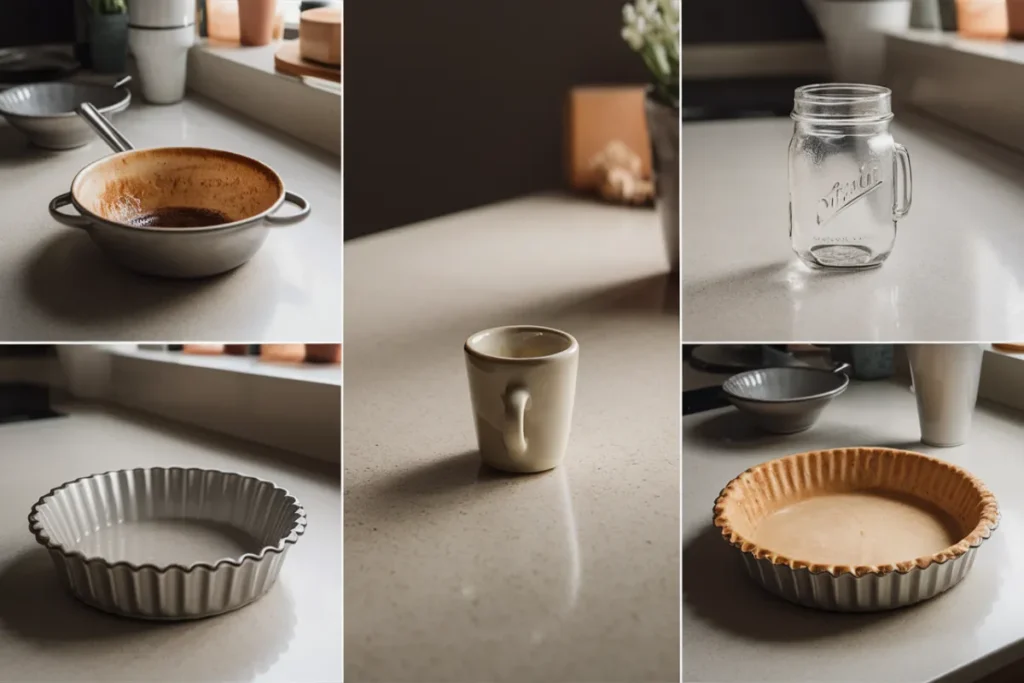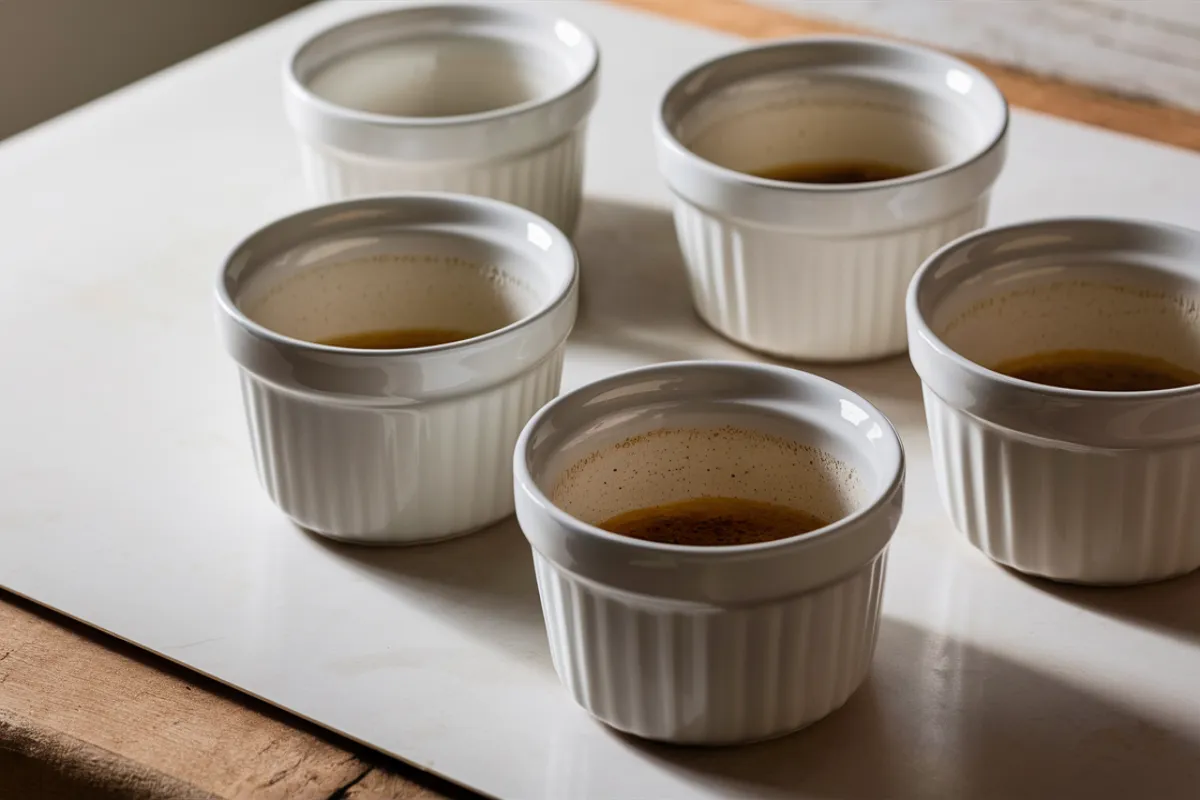Crème brûlée, with its luscious custard base and crisp caramelized sugar topping, is a dessert that has earned a place in the hearts of many. Traditionally, it’s prepared and served in small, round, shallow dishes known as ramekins. But do you have to use ramekins for crème brûlée? This is a question many home bakers and dessert enthusiasts ask, especially when they’re eager to try their hand at making this classic French dessert but don’t have ramekins on hand. In this detailed guide, we’ll explore whether ramekins are truly necessary for crème brûlée, what alternatives can be used, and how to achieve the perfect texture and presentation with or without them.
What Are Ramekins, and Why Are They Used for Crème Brûlée?
Before delving into whether you have to use ramekins for crème brûlée, it’s important to understand what ramekins are and why they’re traditionally used for this dessert. Ramekins are small, cylindrical dishes that are typically made from ceramic, porcelain, or glass. They range in size from 4 to 8 ounces and are known for their durability and ability to withstand high oven temperatures.
Ramekins are ideal for crème brûlée because their shape and size allow for even cooking of the custard. The shallow depth ensures that the custard sets uniformly, while the wide surface area is perfect for creating a thin, crackly layer of caramelized sugar on top. Additionally, ramekins are visually appealing, making them perfect for serving individual portions of crème brûlée directly from the oven to the table.
Do You Have to Use Ramekins for Crème Brûlée?
The short answer to the question, “Do you have to use ramekins for crème brûlée?” is no, you don’t have to use ramekins. While ramekins are the traditional and most commonly used vessel for this dessert, they are not the only option. There are several alternatives that can work just as well, provided you understand how to adjust the cooking process to achieve the best results.
Alternative Dishes You Can Use for Crème Brûlée

If you don’t have ramekins on hand, don’t worry—there are several other dishes you can use to make crème brûlée. Each alternative comes with its own set of benefits and considerations. Here are some popular options:
1. Shallow Baking Dishes
Shallow baking dishes, such as gratin dishes or small casserole dishes, can be used in place of ramekins. These dishes are typically wider and may have a lower edge than ramekins, which means the custard layer will be thinner, and the cooking time will be shorter. This can actually be beneficial if you prefer a higher ratio of caramelized sugar to custard.
When using shallow baking dishes, keep in mind that the custard may set more quickly, so you’ll need to monitor it closely during baking to prevent overcooking. The larger surface area also allows for more caramelization, which can be a plus for those who love that crunchy sugar topping.
2. Espresso Cups or Coffee Cups
Espresso cups or small coffee cups can be a great alternative to ramekins, especially if you want to create individual servings of crème brûlée. These cups are usually smaller than ramekins, so you may need to adjust the recipe quantities or use more cups to accommodate the same amount of custard.
The advantage of using espresso cups is that they often have a handle, making them easier to handle when hot. However, because they are deeper than ramekins, the custard may take longer to set, and the caramelization process may require more attention to ensure even browning.
3. Mason Jars
Particularly the smaller 4-ounce or 8-ounce varieties, can be used to make crème brûlée. Mason jars are not only practical but also add a rustic, charming touch to the presentation. They are oven-safe and can be used to bake the custard directly.
When using Mason jars, be aware that the thickness of the glass can affect the cooking time. The custard may take slightly longer to set, and you may need to adjust the baking time accordingly. Additionally, because Mason jars are deeper than ramekins, the ratio of custard to caramelized sugar will differ, which may affect the overall texture of the dessert.
4. Tart Pans
Tart pans, especially those with removable bottoms, can also be used for making crème brûlée. These pans typically have a wide, shallow design, which allows for a thinner custard layer and more caramelized sugar on top. This can be ideal if you prefer a higher sugar-to-custard ratio.
Using tart pans for crème brûlée can result in a dessert that is more like a crème brûlée tart. The custard will set more quickly due to the shallow depth, so you’ll need to watch it closely to avoid overcooking. The presentation is unique and can add an elegant touch to your dessert spread.
5. Pie Dishes
If you’re making crème brûlée for a larger group, you can use a pie dish to create a family-style version of the dessert. A pie dish allows you to make a larger batch of custard and caramelize the sugar on top in one go.
When using a pie dish, the custard layer will be thicker than in individual ramekins, so the cooking time will need to be adjusted accordingly. The larger surface area is perfect for achieving a generous layer of caramelized sugar, which can be cracked and shared among guests.
How to Adjust Baking Time and Temperature for Different Dishes
When you’re not using ramekins for crème brûlée, adjusting the baking time and temperature is essential to ensure the custard sets properly without overcooking. Here are some general guidelines:
1. Thinner Custard Layers:
For dishes that create a thinner layer of custard, such as shallow baking dishes or tart pans, reduce the baking time by 5-10 minutes. The custard will set more quickly, so it’s important to keep a close eye on it.
2. Deeper Custard Layers:
For deeper dishes, such as espresso cups or Mason jars, you may need to increase the baking time by 5-10 minutes. The thicker custard layer will take longer to set, so be patient and check the custard’s consistency regularly.
3. Lower Oven Temperature:
If you’re using a dish that conducts heat differently, such as glass Mason jars, consider lowering the oven temperature by 10-15 degrees Fahrenheit. This will help prevent the custard from cooking too quickly or developing a skin on top.
4. Use a Water Bath:
Regardless of the dish you’re using, always bake crème brûlée in a water bath. This helps regulate the temperature and ensures even cooking. Place the filled dishes in a larger baking pan, and add hot water to the pan until it reaches about halfway up the sides of the dishes. This gentle cooking method is key to achieving a smooth, creamy custard.
5. Test for Doneness:
The best way to check if your crème brûlée is done is to gently shake the dish. The custard should be set around the edges but still slightly jiggly in the center. It will continue to firm up as it cools. If the custard appears too liquid, continue baking in 5-minute increments, checking frequently.
Achieving the Perfect Caramelized Sugar Topping Without Ramekins
The caramelized sugar topping is one of the most iconic elements of crème brûlée. Even if you’re not using ramekins, it’s important to get this part right. Here’s how to achieve the perfect caramelized sugar topping:
1. Use Fine Sugar:
For the best results, use fine granulated sugar or caster sugar. These sugars melt more evenly and create a smooth, crackly topping. Sprinkle an even layer of sugar over the chilled custard, ensuring it covers the entire surface.
2. Use a Kitchen Torch:
A kitchen torch is the best tool for caramelizing sugar on crème brûlée. Hold the torch a few inches above the sugar, and move it in a circular motion until the sugar melts and turns a deep golden brown. Be careful not to hold the flame too close or stay in one spot for too long, as this can cause the sugar to burn.
3. Use a Broiler:
If you don’t have a kitchen torch, you can use your oven’s broiler to caramelize the sugar. Preheat the broiler, and place the dishes on the top rack of the oven. Broil for 1-2 minutes, watching closely to prevent burning. Rotate the dishes if necessary to ensure even caramelization.
4. Let the Sugar Harden:
After caramelizing the sugar, let it sit for a minute or two to harden. This will create the classic crackly topping that makes crème brûlée so satisfying to eat. Serve immediately for the best texture.
Common Mistakes to Avoid When Making Crème Brûlée Without Ramekins
When making crème brûlée without ramekins, a few common mistakes can affect the outcome. Here’s what to avoid:
1. Overfilling the Dishes:
Overfilling can cause the custard to spill over the sides or cook unevenly. Fill the dishes to about three-quarters full to allow room for the custard to expand slightly as it cooks.
2. Skipping the Water Bath:
The water bath is crucial for even cooking. Skipping this step can result in a custard that is overcooked on the edges and undercooked in the center. Always use a water bath, regardless of the type of dish you’re using.
3. Using Too Much Sugar:
Using too much sugar for the topping can result in a thick, hard layer that’s difficult to crack. Stick to a thin, even layer of sugar for the best results.
4. Overbaking the Custard:
Overbaking can cause the custard to become grainy or curdled. Remember that the custard will continue to set as it cools, so remove it from the oven when it’s still slightly jiggly in the center.
Benefits of Using Alternatives to Ramekins
While ramekins are the traditional choice for crème brûlée, using alternative dishes can offer several benefits:
1. Customization:
Using different dishes allows you to customize the portion sizes and presentation of your crème brûlée. Whether you want to serve individual portions or a larger, family-style dessert, there’s an option to suit your needs.
2. Creativity:
Alternative dishes can add a creative twist to your crème brûlée. From rustic Mason jars to elegant tart pans, the presentation possibilities are endless. This can make your dessert stand out and add a unique touch to your dinner table.
3. Accessibility:
Not everyone has ramekins at home, but most people have other oven-safe dishes that can be used. By using what you already have, you can enjoy crème brûlée without needing to purchase special equipment.
4. Versatility:
Many alternative dishes, such as Mason jars or tart pans, can be used for a variety of other recipes. This makes them a versatile addition to your kitchen, as they can be repurposed for different types of cooking and baking.
Creative Variations of Crème Brûlée
While the classic vanilla-flavored crème brûlée is beloved by many, there are countless variations you can try to add a new twist to this dessert. Here are a few ideas:
1. Chocolate Crème Brûlée
For a rich and decadent treat, add melted dark chocolate to the custard mixture before baking. The result is a creamy, chocolatey custard with the same signature caramelized sugar topping.
2. Coffee Crème Brûlée
Infuse the custard with espresso or strong coffee to create a coffee-flavored crème brûlée. This variation pairs beautifully with the caramelized sugar and adds a sophisticated touch to the dessert.
3. Citrus Crème Brûlée
Add lemon, orange, or lime zest to the custard mixture for a refreshing citrus twist. The bright, tangy flavor of the citrus complements the sweetness of the custard and the caramelized sugar.
4. Lavender Crème Brûlée
Infuse the cream with dried lavender buds for a floral, aromatic dessert. Lavender adds a unique flavor profile that pairs well with the creamy custard and crisp sugar topping.
5. Spiced Crème Brûlée
Add warm spices like cinnamon, nutmeg, and cloves to the custard for a spiced version of crème brûlée. This variation is perfect for the fall and winter months, offering a cozy, comforting flavor.
Frequently Asked Questions
Q: Do you have to use ramekins for crème brûlée?
No, you don’t have to use ramekins for crème brûlée. While they are the traditional choice, there are several alternatives that can work just as well, such as shallow baking dishes, espresso cups, Mason jars, tart pans, and pie dishes.
Q: What can I use instead of a kitchen torch to caramelize the sugar?
If you don’t have a kitchen torch, you can use your oven’s broiler to caramelize the sugar. Preheat the broiler, place the dishes on the top rack, and broil for 1-2 minutes, watching closely to prevent burning.
Q: Can I make crème brûlée in advance?
Yes, you can make crème brûlée in advance. Prepare the custard and bake it as instructed, then chill the dishes in the refrigerator. Just before serving, caramelize the sugar topping for the best texture.
Q: How can I tell if my crème brûlée is done baking?
To check if your crème brûlée is done, gently shake the dish. The custard should be set around the edges but still slightly jiggly in the center. It will continue to firm up as it cools.
Q: Can I use flavored sugars for the topping?
Yes, you can use flavored sugars, such as vanilla or cinnamon sugar, for the topping. These sugars can add an extra layer of flavor to your crème brûlée. However, make sure the sugar is finely ground for even caramelization.
Final Thoughts: Do You Have to Use Ramekins for Crème Brûlée?
So, do you have to use ramekins for crème brûlée? While ramekins are the traditional choice, they are not the only option. With a little creativity and some adjustments to the baking process, you can use a variety of alternative dishes to make this classic dessert. Whether you opt for shallow baking dishes, espresso cups, Mason jars, tart pans, or pie dishes, the key is to understand how to achieve the perfect texture and caramelized sugar topping, regardless of the dish you use.
By exploring these alternatives, you can enjoy the rich, creamy indulgence of crème brûlée even if you don’t have ramekins on hand. So go ahead, try out different dishes, experiment with flavors, and make this iconic dessert your own. Crème brûlée is a versatile and elegant dessert that can be customized to suit your preferences, and with the right techniques, you can achieve delicious results every time.

